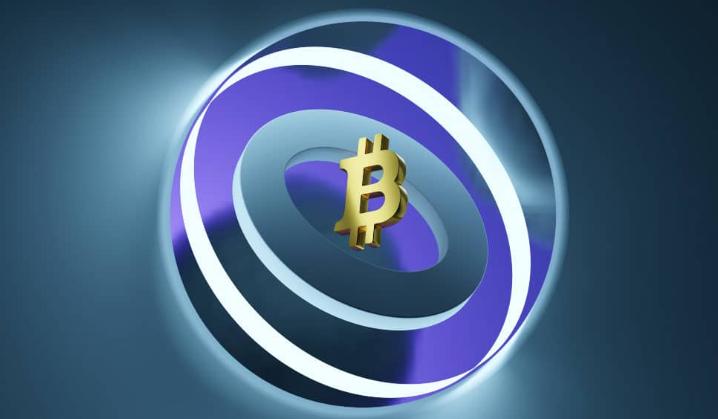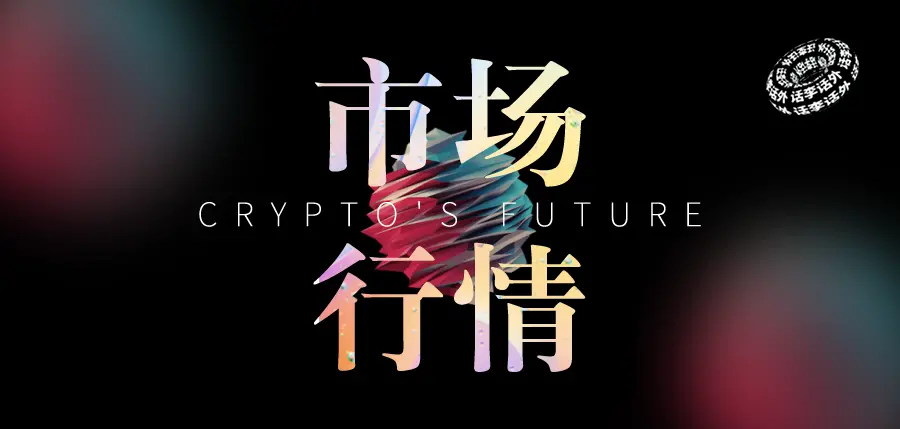Recursive Inscription: Infinite Creativity and Combinatorial Possibilities on the Bitcoin Chain
Written by: Darren, Everest Ventures Group
Abstract:
Since the launch of the Bitcoin on-chain protocol Ordinals and the subsequent explosion of Brc20 by Ordi, innovations based on Ordinals have emerged one after another. Recently, a noteworthy innovation has surfaced—recursive inscriptions. Recursive inscriptions have the ability to reference existing inscriptions on-chain and can engrave a large amount of code onto the Bitcoin blockchain. Additionally, since recursive inscriptions call upon code (presented in text form), their size is minimal, allowing them to break through the Bitcoin block size limit of 4MB, enabling complex 3D video games to be fully uploaded to the Bitcoin blockchain. This innovation brings limitless imagination to the development of Ordinals, making scalability and interoperability on the Bitcoin blockchain possible.
This article will delve into recursive inscriptions from four perspectives: their origins, implementation methods and extent, potential impacts, and possible risks. It is important to note that the code discussed in this article is quite easy to understand, so even readers without a technical background can follow the logic of the article to grasp its essence.
1. What are Ordinals and Brc20
Before discussing recursive inscriptions, let's first clarify what Ordinals and Brc20 are. The Ordinals protocol is a system for numbering satoshis, assigning a serial number to each satoshi and tracking them in transactions. In short, users can attach additional data through Ordinals, making each satoshi unique. This process is called "inscription." "Satoshi" is named after Bitcoin's creator Satoshi Nakamoto (a pseudonym) and is the smallest unit of Bitcoin (BTC). One Bitcoin can be divided into 100 million satoshis, meaning each satoshi is worth 0.00000001 Bitcoin. The numbering of satoshis is determined by the order in which they are mined and transferred. The numbering scheme is based on the order of mining, while the transfer scheme is based on the order of transaction inputs and outputs, hence the term "Ordinals."
BRC20 refers to a Bitcoin token standard based on blockchain technology. BRC stands for "Blockchain Token Standard," and the number 20 indicates the version of this standard. The BRC20 standard defines a set of rules and protocols for creating and managing blockchain-based tokens. The BRC20 standard is similar to the ERC20 standard on Ethereum, providing a universal way to create and operate tokens. BRC20 tokens can be issued, transferred, and traded on compatible blockchains. This standard specifies the basic functions of tokens, such as total supply, token name, symbol, decimal places, and standard interfaces and events for token transactions. By adopting the BRC20 standard, developers can more easily create and deploy their own tokens, facilitating the circulation and trading of tokens on the Bitcoin blockchain. The emergence of the BRC20 standard has promoted the development of the cryptocurrency ecosystem and the Bitcoin ecosystem, allowing different projects to better interoperate and be compatible with each other.
2. The Origin of Recursive Inscriptions
The origin of recursive inscriptions can be described as a chain reaction. Since Brc20 caused a stir, the community began to ponder why, if Brc20 could succeed by referencing Erc20, they couldn't create a Brc721 by referencing Erc721? Thus, Brc721 was born. However, since most Erc721 store images in centralized hosting, requiring management fees, Brc721 directly engraves images onto the Bitcoin blockchain, presenting a significant cost challenge. As Ordinals gained popularity, the congestion of inscriptions on the Bitcoin blockchain became increasingly severe, further exacerbating cost pressures.
To address this issue, Gbrc721 was created, successfully overcoming the high costs associated with on-chain operations. In the development of the Gbrc721 project, the project team only needed to upload components of the NFT and cleverly combine them. For example, a 10K collection might only require 200 components, including mouths, ears, noses, etc. This greatly reduced the cost of on-chain operations. However, this also introduced a new problem: the need for off-chain image parsing to display images. Therefore, the Gbrc721 project "Ordibots," currently displayed on MagicEden, still presents as a string of text (as shown in the image below).
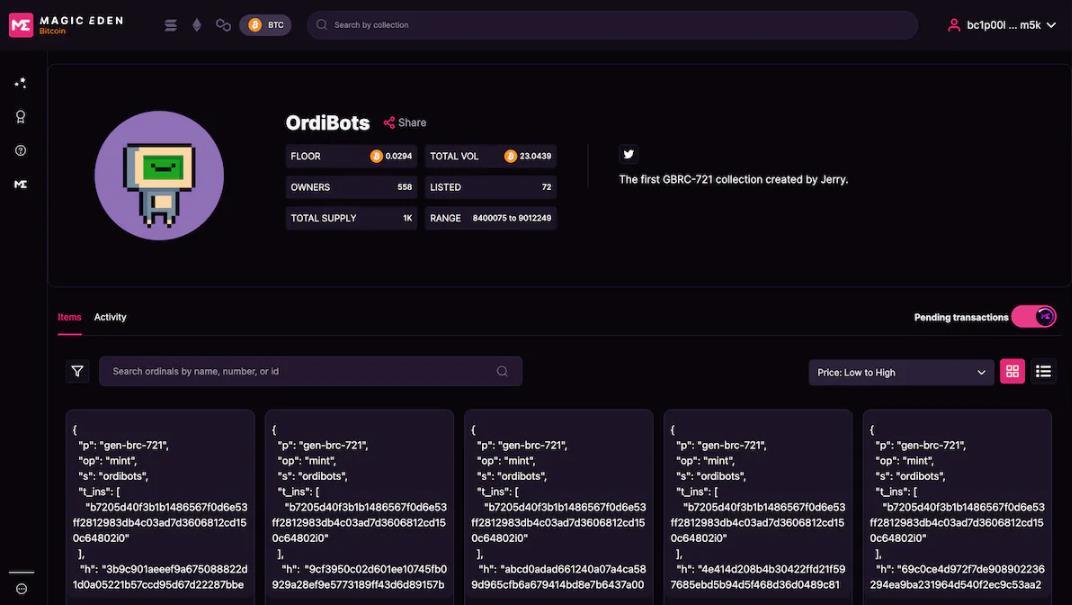
The concept of recursive inscriptions was proposed by the founder of the Bitcoin protocol Ordinals. On June 12, 2023, Raph, the new chief maintainer of Ordinals, announced a significant advancement on GitHub, merging the innovation of the inscription "recursive inscription" numbered 2167 into the code of Ordinalsd (as shown in the image below). In this version of the code, the syntax "/-/content/:inscription_id" allows inscriptions to reference each other's content, achieving functionality that surpasses Gbrc721. This innovation is implemented directly on-chain, without relying on off-chain parsing, fundamentally solving the problems of Gbrc721. Thus, recursive inscriptions were born, and this simple yet clever change brought limitless creativity to Ordinals, igniting people's imagination.
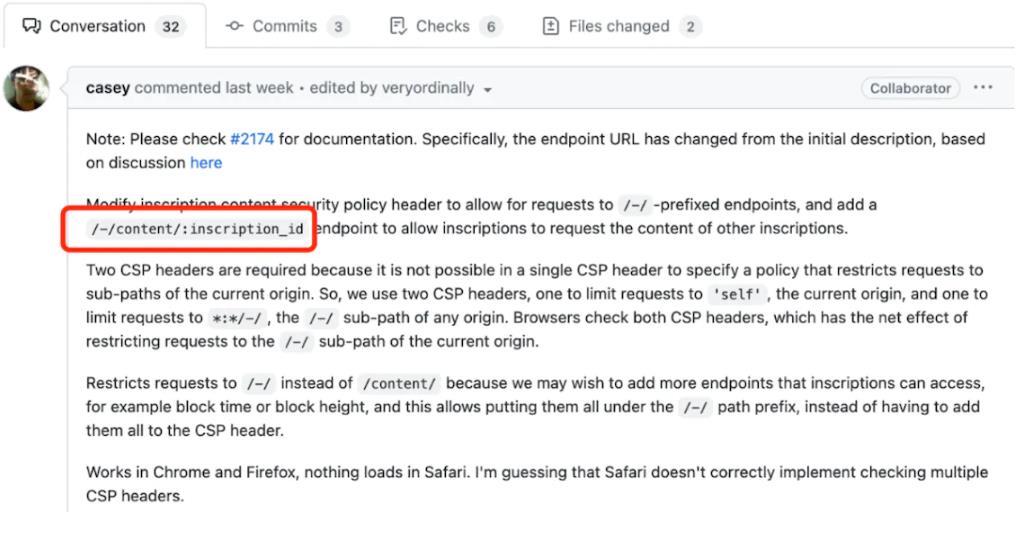
3. Implementation and Effects: Exploring Endless Combinatorial Possibilities
In the previous section, we learned about the origins of recursive inscriptions. Next, this article will specifically explore the implementation methods of recursive inscriptions. We will also look into what led to the dramatic launch of the first recursive inscription project—"Recursive Punks"; how various components are integrated during the recursive process; and the extent to which the combinatorial capabilities of recursive inscriptions can be achieved, including whether different formats of recursive inscriptions can be combined. We will unravel these mysteries together and explore the endless combinatorial possibilities brought by recursive inscriptions.
Implementation Method of Recursive Inscriptions
The implementation of recursive inscriptions relies on the wisdom and technical breakthroughs of the founding team of Ordinals. They embedded the code shown in the image below into the underlying protocol, where "/content/" is the key to code referencing, enabling developers to reference other inscriptions that already exist on the Bitcoin blockchain. For readers who carefully study the code, it is not difficult to notice that the code presented here (version 2174) differs from the previously mentioned version 2167 (version 2174 removed the "/-" part). Version 2167 was the initially adopted version, but subsequently, the Ordinals founding team abandoned version 2167 in favor of version 2174. This also set the stage for the dramatic launch of "Recursive Punks."

The Dramatic Launch of Recursive Punks
On June 13, Recursive Punks officially announced the free minting of ten thousand Recursive Ordinals series, which immediately sparked heated discussions and dissemination within the community. Due to the principle of "First is First," the project was quickly inscribed after being discovered by the community, and at its peak, it even caused the website to crash. However, after a wave of fervent FOMO minting, many users were surprised to find that the recursive inscription version used by the official team was actually the old version 2167, while the correct recursive inscription syntax should be "/content/," but the official used "/-/content/:". This led to Recursive Punks not displaying images properly on the Bitcoin inscription browser, so strictly speaking, the project was not a true recursive inscription project.
The community then began to spread a fix and pointed out the syntax error in Recursive Punks. However, the official team chose an unexpected approach upon discovering the project's syntax error, tweeting their hope that both the developers of the Ordinals protocol and the community would recognize both the version without images and the version with images. Even more surprising to the community was that the official team later deleted that tweet and directly launched the image-less version of Recursive Punks on MagicEden, showcasing it in high-definition images. Technical analysis indicated that this was achieved through front-end rendering, allowing this version to display images on the MagicEden platform. This action sparked dissatisfaction among some community members, who felt that this behavior severely violated the principles of decentralization, with some even considering it a form of fraud.
Currently, both the V1 and V2 versions of Recursive Punks have been launched on MagicEden. As of today (June 20, 2023), the V1 version (image-less version) of Recursive Punks has a higher trading volume, so it may be considered that the official V1 version still holds more consensus within the community. The principle of "First is First" remains widely recognized. However, as knowledge of recursive inscriptions spreads, the true recursive inscription version Recursive Punks v2 may gain more support and recognition.
The Clever Combination of Components in Recursive Inscriptions
In recursive inscriptions, utilizing the aforementioned "/content/" syntax code, project teams can directly reference existing NFT components on-chain to create their own NFT works. This article uses the recursive inscription project "Recursive Frogs" as an example to illustrate the intricacies. As shown in the image below, the red box displays the components of this NFT work (currently, Ordiscan supports the display of recursive inscription components and one-click linking to component URLs).
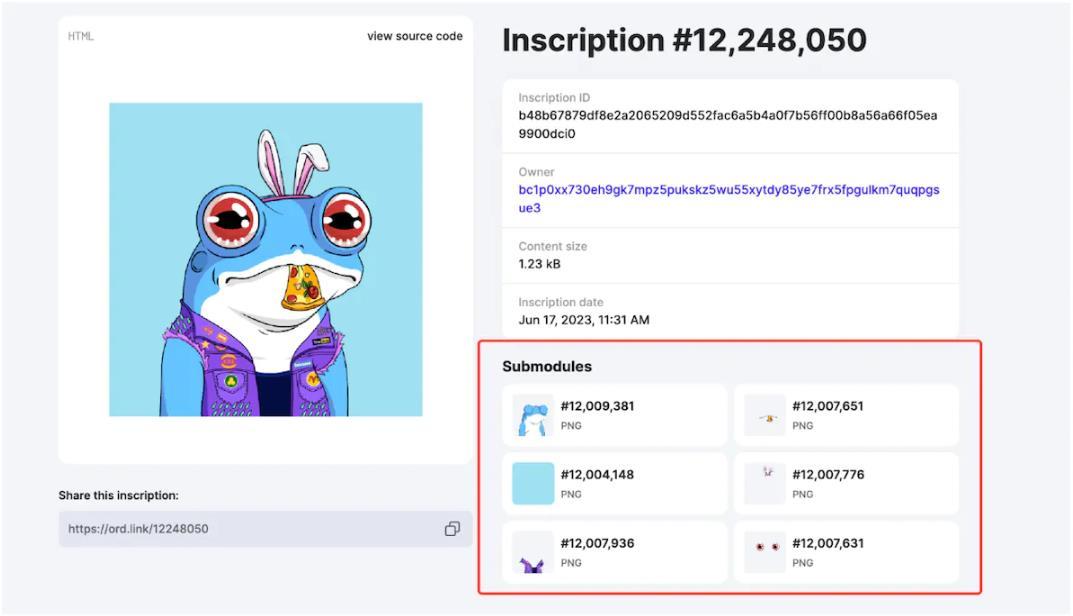
Next, we click on the "view source code" indicated by the red arrow to view the source code of this NFT work.
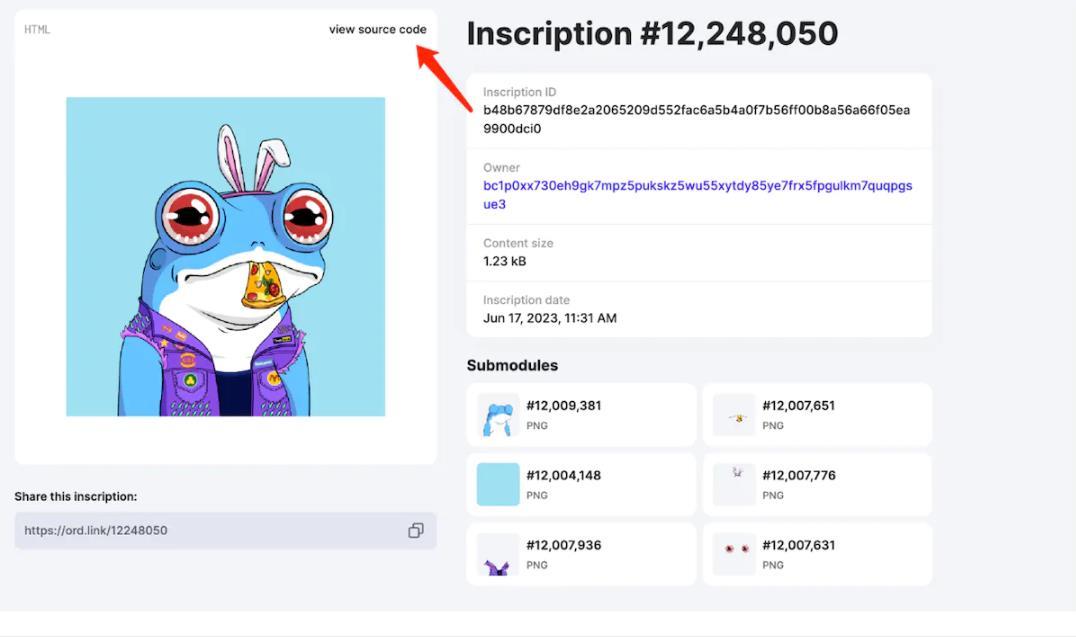
These six lines of code utilize the "content" syntax, effectively referencing six different components, with the string of code following "/content/" corresponding to each component's "Inscription ID."
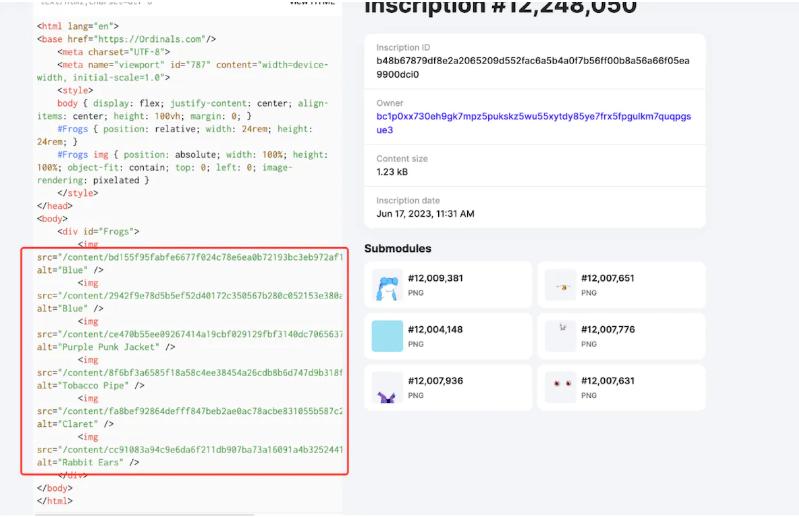
Through this clever component referencing method, creators of recursive inscriptions can blend various elements together to create unique works. This infinite combinatorial possibility not only inspires the imagination of creators but also brings a new dimension to the development of recursive inscriptions. Whether it is art pieces, digital collectibles, or virtual reality games, the combinatorial capabilities of recursive inscriptions can bring unprecedented possibilities to the creative field.
The Infinite Combinations and Fusion of Different Formats in Recursive Inscriptions
Recursive inscriptions theoretically possess a high degree of combinability, allowing for flexible combinations of various inscriptions on the Bitcoin blockchain. This infinite combinability has led many industry pioneers to see the potential of recursive inscriptions in bringing innovative application scenarios such as GameFi and the metaverse to Ordinals. Recursive inscriptions can combine different formats of inscriptions into a webpage presented in HTML format. The content of this webpage can be freely added by the project team, as long as it can be found on the Bitcoin blockchain. Various content types, such as music, videos, or GIFs, can be integrated within it. Therefore, recursive inscriptions inject tremendous possibilities into the Bitcoin ecosystem, and their creativity and openness provide creators with an unprecedented platform for creation.
4. The Innovative Trend Triggered by Recursive Inscriptions and Prospects for Application Scenarios
The emergence of recursive inscriptions brings infinite possibilities to the Bitcoin ecosystem. Next, we boldly predict some impacts that recursive inscriptions may bring and potential application scenarios.
1. Lowering the Entrepreneurial Threshold and Costs in the Bitcoin Ecosystem
Recursive inscriptions significantly lower the entrepreneurial threshold in the Bitcoin ecosystem, allowing for the creation of entirely new NFT series with just a few lines of code modifications, as demonstrated by the image-less, image, large image, and high-definition image versions of Recursive Punks. Additionally, recursive inscriptions also significantly reduce startup costs; a 10k collection that originally required uploading tens of thousands of images can now be created by uploading just 200 component images and cleverly combining them through code.
2. Enhancing the Richness of Inscriptions
The emergence of recursive inscriptions has prompted Ordinals' underlying inscription browsers (such as ord.io and ordiscan.com) to strive to support various media types beyond the earliest text types, such as SVG, HTML, and JavaScript. Recursive inscriptions can now rival a universal webpage, capable of displaying almost any content found on a webpage. Furthermore, recursive inscriptions can reference other inscriptions, akin to upgrading a local webpage to the internet, greatly enriching the expressive forms of inscriptions.
3. GameFi and the Metaverse
The emergence of recursive inscriptions has made the realization of GameFi and the metaverse on the Bitcoin blockchain possible. Mini-games based on recursive inscriptions have already appeared, such as the one shown in the image below, developed by Ordz Games. Players can directly click to interact with it on the inscription browser, with gameplay similar to the previously popular "Sheep Game," which is the "webpage" realization mentioned earlier.

As mentioned earlier, recursive inscriptions, due to their code-calling characteristics, achieve a compact size. This feature allows the size of inscriptions to break through the Bitcoin block size limit of 4MB. Thus, theoretically, we can construct a metaverse and GameFi on the Bitcoin blockchain, even uploading complex 3D games to the Bitcoin blockchain. Of course, it should be noted that recursive inscriptions are still in their early stages, and all these ideas and concepts need to be realized through continuous exploration and discovery.
5. Potential Risks of Recursive Inscriptions
Centralization Risks: The implementation of recursive inscriptions relies on the Ordinals protocol. As mentioned earlier, the realization of recursive inscriptions is built upon the Ordinals protocol. If the Ordinals protocol does not embed or later removes the "reference" part of the code, recursive inscriptions will become unusable.
Burden on the Bitcoin Network: In the short term, recursive inscriptions may bring some prosperity to the Bitcoin ecosystem. However, images, movies, code repositories, software codes, and various new data inscriptions may accumulate in the Bitcoin memory pool. As registrars bid higher to confirm transactions, ordinary users who only wish to pay for purchases with Bitcoin will have to pay expensive premiums. Therefore, in the long term, the Bitcoin network may become more congested, and transaction fees may become more expensive.
Lowering the Cost of Malicious Acts: Recursive inscriptions may make it easier for fraudsters to add malware to the Bitcoin blockchain. Fraudsters can split malware into multiple files and add it to users' devices when they download games, files, or software. This could lead to downloaders losing funds.
Dependence on Support from Underlying Infrastructure: Recursive inscriptions also require more support from underlying infrastructure, such as leading exchanges like Unisat and MagicEden, major inscription browsers, and centralized exchanges like OKEX and BINANCE. As of today (June 20, 2023), MagicEden has not yet supported the image display of the aforementioned Recursive Punks V2 version (as shown in the images below), and the normal display of Recursive Frogs was only achieved after a suggestion from a community KOL.
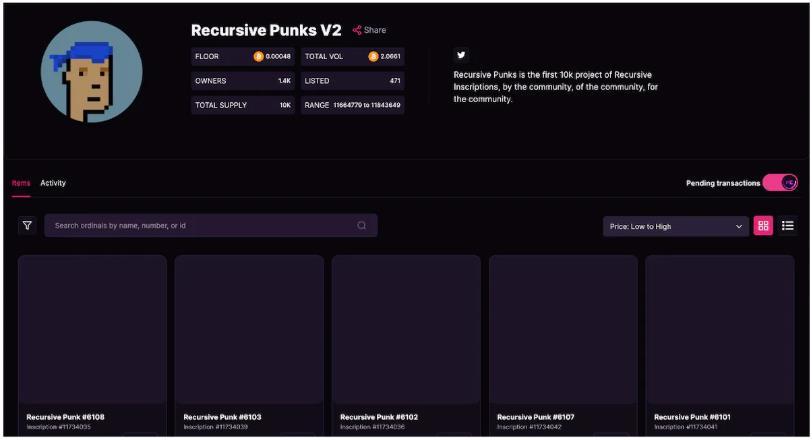
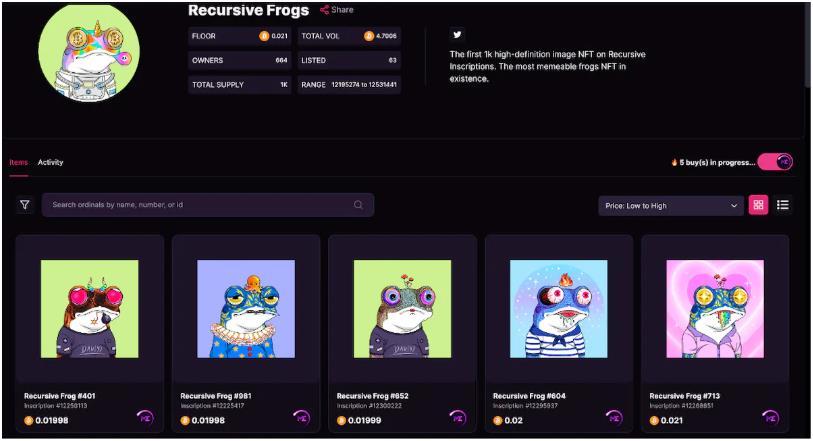
6. Conclusion
The emergence of recursive inscriptions has sparked widespread discussion within the Bitcoin ecosystem and may have profound impacts on both the Bitcoin ecosystem and the entire industry. Of course, while we are optimistic about the infinite possibilities that recursive inscriptions can bring, we must also recognize that they are still in their early stages and require continuous exploration and discovery, as well as more support from project teams. Therefore, before engaging in adventurous attempts and investments, we should always maintain a sense of risk awareness.



